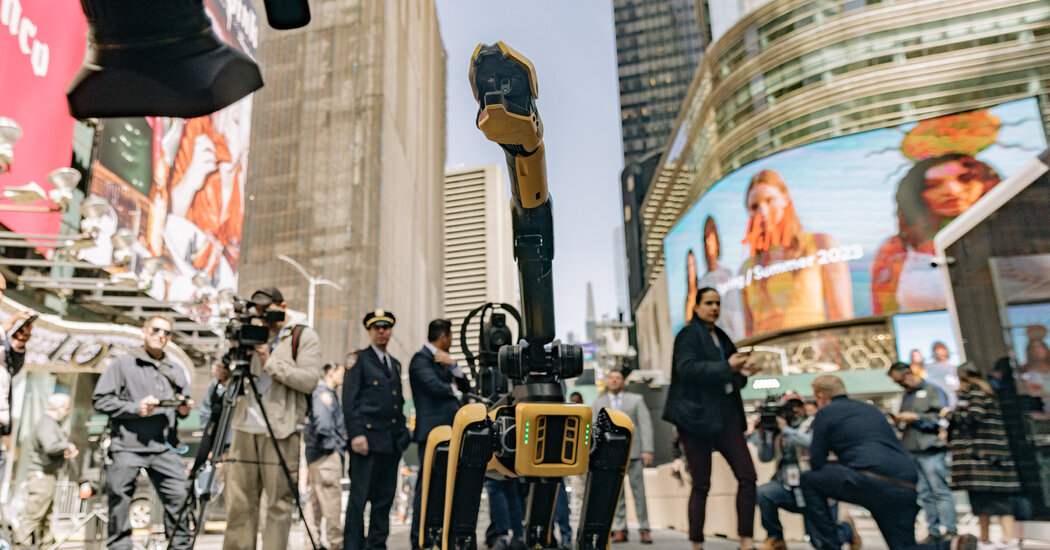The police-cordoned-off block of Times Square on Tuesday made the so-called crossroads of the world look even more dystopian than usual.
There were two security robots that onlookers compared in appearance to R2-D2 from “Star Wars” or a Dalek from “Doctor Who,” as well as a gun-shaped device that police officers can use to shoot GPS-enabled trackers onto fleeing vehicles.
Then there was the return of Digidog, a robotic dog that the police would use in life-threatening situations.
And presiding over all of it was Mayor Eric Adams, who told the assembled news media that his continuing efforts to combat crime would most assuredly include robotic dogs — almost two years to the day after the New York Police Department bowed to public criticism and stopped using the technology.
“Digidog is out of the pound,” the mayor said.
Mr. Adams rose to power in 2021 with the argument that only he, a retired police captain and a police critic, could restore order to New York City streets without endangering New Yorkers’ civil liberties.
But a year into Mr. Adams’s tenure, his public safety agenda remains a work in progress. His first year in office saw a drop in shootings and murders, but an overall rise in major crimes, including burglaries and robberies.
Mr. Adams and his police commissioner, Keechant Sewell, on Tuesday said that since the advent of bicycles and fingerprinting and mug shots, technology has been, and will continue to be, key to enhancing public safety. Notwithstanding the budgetary headwinds, the mayor suggested he had no plans to cut back on these sorts of investments.
“We are scanning the globe on finding technology that will ensure this city is safe for New Yorkers, visitors and whomever is here in the city,” Mr. Adams said. “This is the beginning of a series of rollouts.”
The mayor’s predecessor, Bill de Blasio, took a contrasting stance, deciding in 2021 to cut short the city’s contract for the robotic dog.
A Police Department at a Critical Moment
The New York Police Department is facing challenges on several fronts.
“It’s creepy, alienating and sends the wrong message to New Yorkers,” Mr. de Blasio’s spokesman said at the time.
Now, New York City is acquiring two robot dogs for a sum of roughly $750,000, using asset forfeiture funds. Officials said the dogs would not be used for routine patrol, but rather for life-threatening situations, including bomb threats. The robotic dog on display in Times Square was borrowed from the Fire Department, which has been deploying robot dogs since last year.
A spokeswoman for the manufacturer, Boston Dynamics, noted that in October, Florida police used a robot dog to help rescue a 3-year-old hostage. (Boston Dynamics calls its dogs “Spot.”)
Mr. Adams has a longstanding interest in unorthodox policing technologies. As Brooklyn borough president, he held a news conference to demonstrate a lasso-like device for restraining emotionally disturbed people called the BolaWrap, in which his friend, Frank Carone, was an investor. When Mr. Adams became mayor, Mr. Carone became his chief of staff.
The city’s commitment to buy these robotic dogs comes just a week after the mayor directed his agencies to cut their budgets by 4 percent for the coming fiscal year.
The Police Department’s chief of department, Jeffrey Maddrey, said the use of the remote-controlled robot dogs will be subject to his approval. As he spoke, a robotic dog trotted in front of him.
Separately, the Police Department will test out a five-foot-tall robot, manufactured by Knightscope, in the Times Square subway station starting this summer. The department’s seven-month contract, which includes three months to ready the device for use and four months for testing it, will cost $12,250, according to a City Hall spokesman. Initially, the robot will be accompanied by a police officer.
The so-called K5 Autonomous Security Robot, which will be on display in Times Square for two more days, is designed to send intelligence back to the Police Department and to deter crime. Similar robots have been used to patrol Lowe’s parking lots and to keep homeless encampments away from a San Francisco animal shelter.
The Police Department also signed a roughly $19,500, temporary subscription with StarChase for seven devices that will enable the police to tag vehicles with GPS trackers.
“What we want to do is to mitigate as many high-speed chases in the city as possible,” Mr. Adams said.
Ms. Sewell said that neither the robotic dog nor the K5 would be equipped with facial recognition technology.
But significant questions remain, including what information the robots will collect and who will have access to that information.
Donna Lieberman, the executive director of the New York Civil Liberties Union, argued that the Police Department routinely fails to adequately comply with a law requiring it to disclose details about its use of new technologies, a position that the Police Department disputes. .
“We’re left to concoct a narrative about what this technology can and can’t do, what risks it presents, what mitigation of those risks is in place, but we have no hard information,” Ms. Lieberman said. “And all we’re left with is Digidog running around town as this dystopian surveillance machine of questionable value and quite potentially serious privacy consequences.”
The announcement also sparked immediate condemnation from Albert Fox Cahn, the executive director of the Surveillance Technology Oversight Project.
“The N.Y.P.D. is turning bad science fiction into terrible policing,” Mr. Cahn said in a statement. “New York deserves real safety, not a knockoff ‘RoboCop.’”
















Leave a Reply